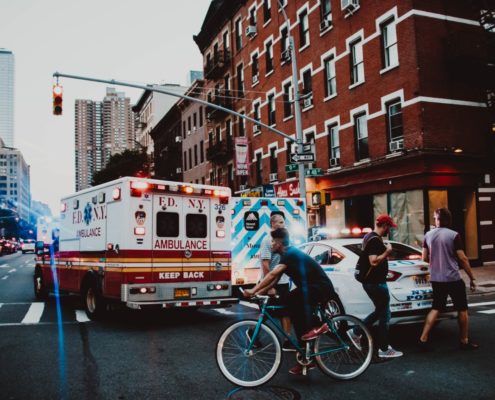How to Promote Pedestrian Safety
In 2018, the National Highway Traffic Safety Administration (NHTSA) reported a total of 6,283 pedestrian deaths due to traffic accidents—an increase of over 3% from previous numbers. While the government and other organizations have done their best to inform pedestrians about proper traffic safety and keep them aware and alert to their surroundings, there is only so much that can be done from their side of the issue.
To truly address the risks and reduce the number of fatalities from pedestrian-vehicle crashes, it is equally important that city planners, businesses, and other property owners do their part to promote safety and protect those who cross their property on foot.
Who Is Considered a Pedestrian?
A pedestrian is generally defined as any individual who is walking, running, jogging, or otherwise moving on foot. Depending on the state, the legal definition of who is considered a pedestrian may also include anyone using a human-powered vehicle other than a bicycle, such as a non-motorized wheelchair, scooter, skateboard, or roller/inline skates.
Drivers of cars, trucks, motorcycles, and other such motor vehicles are obviously not pedestrians. A person riding a bike is also typically not considered a pedestrian, though they may be considered one if they are walking with their bike rather than riding it.
The Importance of Keeping Pedestrians Safe
Protecting pedestrians from traffic accident injuries is important for a number of reasons. Most importantly, a pedestrian who is hit by a car can be seriously hurt, leading to chronic pain, permanent disability, or even death. This can leave victims and their families struggling to cope with physical, financial, and emotional stress that drastically affects their lives. Similarly, the driver of the vehicle involved may face serious legal repercussions or life-threatening injuries themselves.

From the perspective of the owner of the property where the accident occurred, a crash involving one or more pedestrians can present an issue of liability. If the accident is in any way affected by poor signage, lax safety measures, or improper maintenance on the premises, the property owner may be held at least partially liable for the accident and suffer both financial losses and harm to their public image.
How to Ensure Protection on Your Property
The following are just a few ways you can make your property better for pedestrians and keep your business, employees, and customers safe from the repercussions of pedestrian accidents.
Provide Dedicated Pedestrian Walkways
Make sure that anyone who visits or works on your property is able to get around on foot via dedicated pedestrian areas like crosswalks, sidewalks, and other appropriate walking paths. Pedestrian walkways that cross over roads or parking lots should always be clearly marked as such so that both drivers and pedestrians can recognize the area. Sidewalks and other paths should be easily accessible to pedestrians and connect up with crosswalks where appropriate.
Know what your state and local laws are regarding these walkways and be sure to obey all requirements to protect both pedestrians and yourself.
Put Up Appropriate Signage
Use signs directing traffic to stop, slow, or yield to pedestrians wherever they are needed. Adding either a stop or yield sign to a crosswalk helps clarify to drivers that they must give pedestrians an opportunity to cross at that location. This can be especially helpful in areas where drivers seem to ignore crosswalks or weather makes it difficult to see the painted lines on the ground.
Again, make sure to observe any applicable state and local laws regarding required signage and how it should be used.
Keep Parking Lots and Other High-Traffic Areas Well-Maintained
If your parking lot and/or sidewalks are full of hazards, it increases the chance that drivers and/or pedestrians can get into accidents of all kinds. If there is a pothole in your lot, for example, a driver may swerve around it into pedestrian crossing areas. Similarly, an uneven sidewalk along the roadside may cause a pedestrian to stumble out into traffic.
Proper maintenance also means keeping all signage and painted lines clear and visible. Make sure that pedestrian crossings are properly and clearly marked, and that “stop,” “yield,” and other signs are legible and not obscured by any landscaping or objects. A faded crosswalk with a sun-bleached stop sign may make it clear enough to drivers that they should be prepared to stop. Likewise, pedestrians who can’t see the crosswalk may just cross wherever, without realizing there is a safer place for them to walk.
Promote a Culture of Safety in the Workplace
If you’re a business owner, it’s a good idea to promote pedestrian safety as part of your training, as well as support an overall culture of safety throughout the workplace. If you don’t already have one, enact a workplace safety program and get employees thinking about hazard reduction and personal protection. Discuss ways to stay safe, both inside and outside the building, including in parking lots, loading zones, and other areas where vehicles and pedestrians may coexist.
Use ADA Tactile Warning System Products
Not all of the pedestrians who step onto your property are capable of perceiving hazards like the average person. In the U.S., there are more than 7.6 million adults living with some kind of visual disability. For these individuals, bright signage and clearly marked crosswalks simply won’t be as effective as they would for someone fully sighted. To keep these pedestrians safe, the Americans with Disabilities Act (ADA) requires the use of specialized detectable warning surfaces.
The ADA is a piece of legislation that outlines requirements for the fair treatment and accessibility needs of Americans living with a variety of disabilities. The act’s detectable warning surface requirements dictate that certain areas should have tactile surfaces that can be felt physically by those who cannot see where crosswalks, curbs, and vehicles may be. When a visually impaired person steps onto these surfaces, they’ll be able to feel that they are nearing a potentially hazardous area.
Specifically, the ADA requires that all tactile warning surfaces use what is known as a “truncated dome” pattern, which is essentially repeating rows of bumps with their domed tops cut off. The ADA also details the exact specifications to which these domes must be manufactured in order to provide maximum detectability without being slippery or creating a trip hazard themselves.

Detectable warning tiles can be installed along sidewalk curbs, crosswalk transition ramps, subway platforms, etc. to alert visually impaired persons to their location and prevent them from falling into unsafe areas or walking into traffic. They can be manufactured in a variety of colors, but a bright, high-contrast color like yellow is often chosen because it adds an additional visual cue for fully or partially sighted individuals.
Find Durable, Compliant Tactile Warning Panel Products at ADA Solutions
At ADA Solutions, we manufacture a range of ADA-compliant detectable warning surface products to suit a variety of applications. Choose from products like surface-applied, cast-in-place, and cast-in-place replaceable tiles, as well as radius systems for curved areas, extra-durable cast iron surfaces, replaceable graphic tiles, photoluminescent systems, and convenient way-finding surfaces.
Whether you’re laying new walkways for a new project or need to quickly retrofit existing sidewalks with surface-applied tiles, we offer expertly manufactured, slip-resistant, long-lasting tactile warning products to help you meet government requirements and protect pedestrians on your property.
To learn more about the ADA requirements or discuss your detectable warning surface needs, call us today at 1-800-372-0519. You can also request a free quote online.
Sources:




